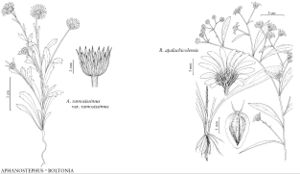Aphanostephus
in A. P. de Candolle and A. L. P. P. de Candolle, Prodr. 5: 310. 1836.
| Taxon | Illustrator ⠉ | |
|---|---|---|
 | Aphanostephus ramosissimus var. ramosissimus Boltonia apalachicolensis | Barbara Alongi Barbara Alongi |
Annuals or perennials, 5–50 cm; taprooted. Stems erect to decumbent or ascending, deflexed proximally, branched, usually spreading-hairy distally (hairs soft to stiff). Leaves basal and cauline; alternate; sessile or petiolate; blades 1-nerved, broadly oblanceolate to linear-lanceolate, margins entire or pinnatifid, faces loosely strigose to hirsute. Heads radiate, borne singly (terminal). Involucres broadly to depressed-hemispheric, 3.5–8 × 4–10 mm. Phyllaries 25–50 in 3–4 series, 1-nerved (midnerves barely evident; not keeled), unequal to subequal, appressed (not reflexing after release of cypselae), ovatelanceolate, margins broadly scarious, faces strigose or hirsute to hispid. Receptacles conic, pitted, epaleate. Ray-florets 10–75 (in 1–2 series), pistillate, fertile; corollas abaxially with broad, purplish midstripe, adaxially white, (closing distally at night, not coiling at maturity). Disc-florets 25–400, bisexual, fertile; corollas yellow (with orange resin ducts), tubes shorter than tubular to funnelform throats (tubes or limbs sometimes swollen and indurate at maturity), lobes 5, erect, deltate; style-branch appendages deltate. Cypselae angular-columnar, usually 4-angled, sometimes subterete (thick-walled), 4–12-thick-ribbed (usually cupped apically), faces usually sparsely strigose (duplex hairs with coiled or recurved apices), sometimes glabrous; pappi 0 or persistent, of tan, basally connate scales, or coroniform (indurate, cupuliform, often ciliate or lacerate, sometimes scaly), or acute or awn-tipped scales or setiform scales in 1 series. x = 5 (4, 3 derived).
Distribution
United States, n Mexico
Discussion
Species 4 (4 in the flora).
Aphanostephus is distinguished from other white-rayed Astereae by its combination of ovate-lanceolate, scarious-margined phyllaries, conic receptacles, usually thick-ribbed, columnar, 4-angled cypselae often bearing duplex hairs with coiled or recurved apices, reduced pappi, and low chromosome number(s). B. L. Turner (1984) emphasized characters of achenial vestiture and chromosome numbers to reduce the number of species from the 11 recognized by L. H. Shinners (1946). Cypsela hairs must be examined with a dissecting microscope to determine their morphology. Leaves may be highly variable in size, shape, and insertion within species, from 15–50 mm, entire to deeply lobed or pinnatifid, and non-clasping to clasping or subclasping.
Aphanostephus was hypothesized to be closely related to Townsendia, Astranthium, and a group of Southern Hemisphere genera (subtribe Brachyscominae) on the basis of various morphologic features (G. L. Nesom 1994). In contrast, molecular data (D. R. Morgan 1990; M. A. Lane et al. 1996; R. D. Noyes 2000; Noyes and L. H. Rieseberg 1999) indicate that Aphanostephus has arisen from within the Conyzinae, apparently as the sister group to the E. bellioides de Candolle group of Erigeron.
Selected References
Lower Taxa
Key
| 1 | Cypsela hairs either 1-directionally apically coiled or glochidiate (cells abruptly reflexed in opposite directions, forming prong); annuals or perennials | > 2 |
| 1 | Cypsela hairs apically straight; annuals | > 3 |
| 2 | Annuals; bases of disc corollas bulbous-swollen (mature); cypsela hairs apically 1-directionally coiled; pappi usually coroniform, uneven, rarely of acute to awn-tipped scales 0.2–2 mm | Aphanostephus skirrhobasis |
| 2 | Perennials; bases of disc corollas not conspicuously swollen; cypsela hairs apically glochidiate; pappi coroniform, minutely ciliate or lacerate, 0.1–0.3 mm | Aphanostephus riddellii |
| 3 | Vestiture sparsely hispido-pilose, stem hairs spreading at right angles, thick-based, straight, 0.6–2.4 mm; ray florets 13–21 | Aphanostephus pilosus |
| 3 | Vestiture puberulent, stem hairs spreading to deflexed, thin-based, 0.2–0.6 mm; ray florets 26–35 | Aphanostephus ramosissimus |